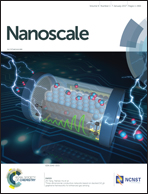Electric field controlled CO2 capture and CO2/N2 separation on MoS2 monolayers†
Abstract
Developing new materials and technologies for efficient CO2 capture, particularly for separation of CO2 post-combustion, will significantly reduce the CO2 concentration and its impacts on the environment. A challenge for CO2 capture is to obtain high performance adsorbents with both high selectivity and easy regeneration. Here, CO2 capture/regeneration on MoS2 monolayers controlled by turning on/off external electric fields is comprehensively investigated through a density functional theory calculation. The calculated results indicate that CO2 forms a weak interaction with MoS2 monolayers in the absence of an electric field, but strongly interacts with MoS2 monolayers when an electric field of 0.004 a.u. is applied. Moreover, the adsorbed CO2 can be released from the surface of MoS2 without any energy barrier once the electric field is turned off. Compared with the adsorption of CO2, the interactions between N2 and MoS2 are not affected significantly by the external electric fields, which indicates that MoS2 monolayers can be used as a robust absorbent for controllable capture of CO2 by applying an electric field, especially to separate CO2 from the post-combustion gas mixture where CO2 and N2 are the main components.


 Please wait while we load your content...
Please wait while we load your content...